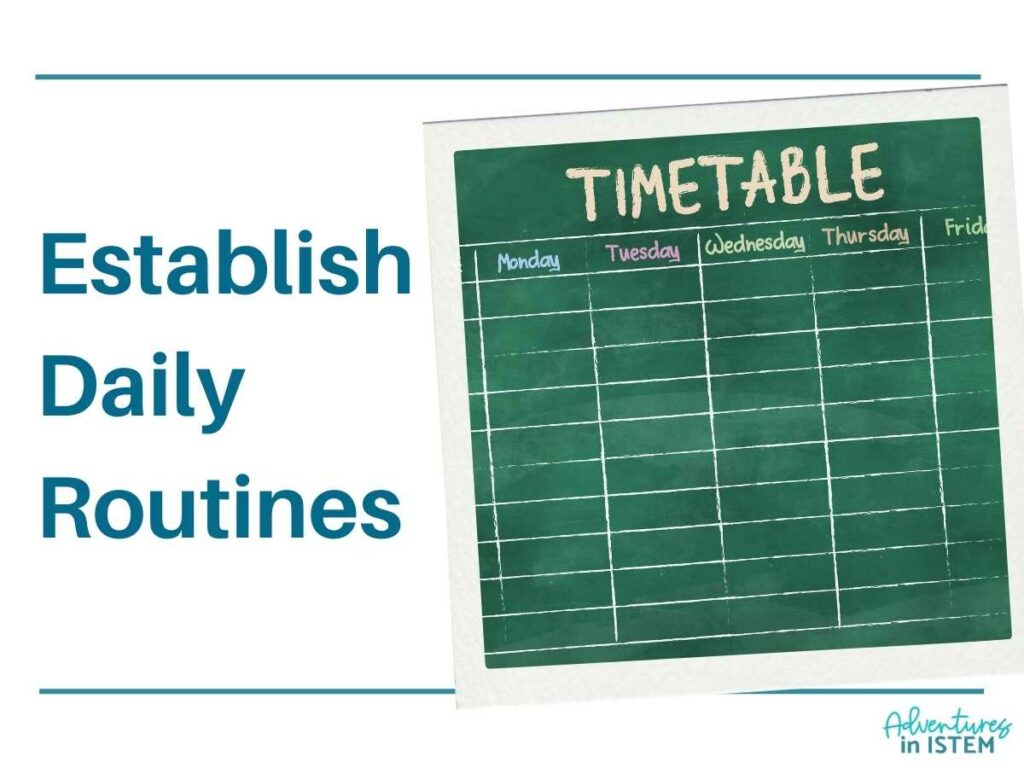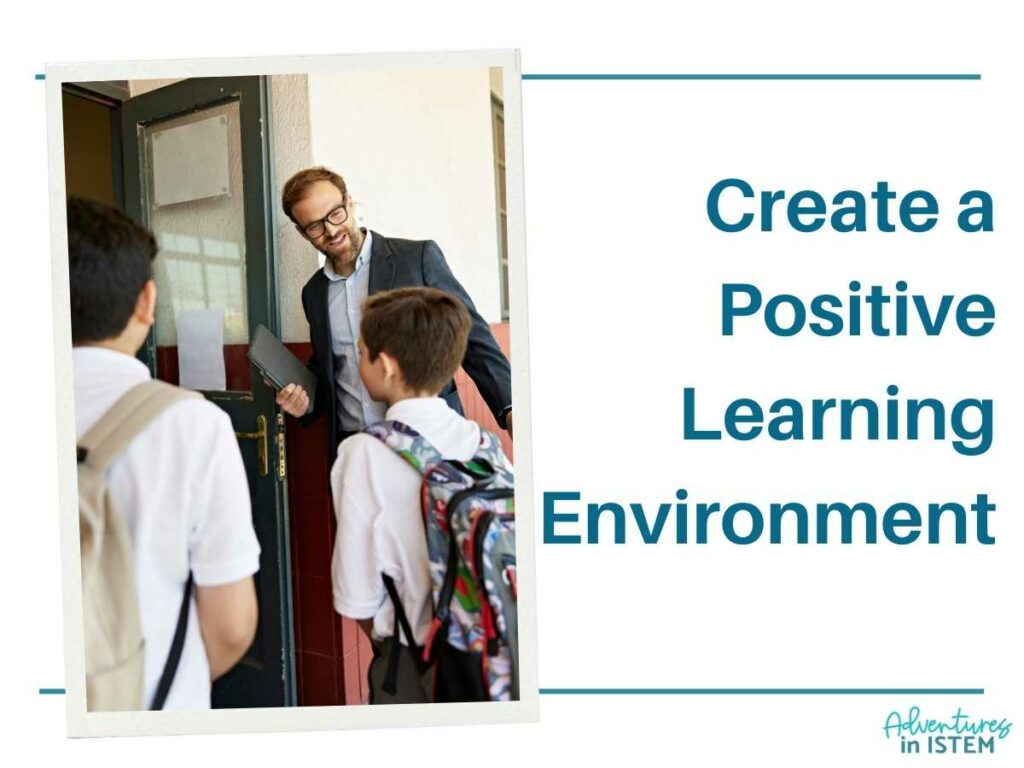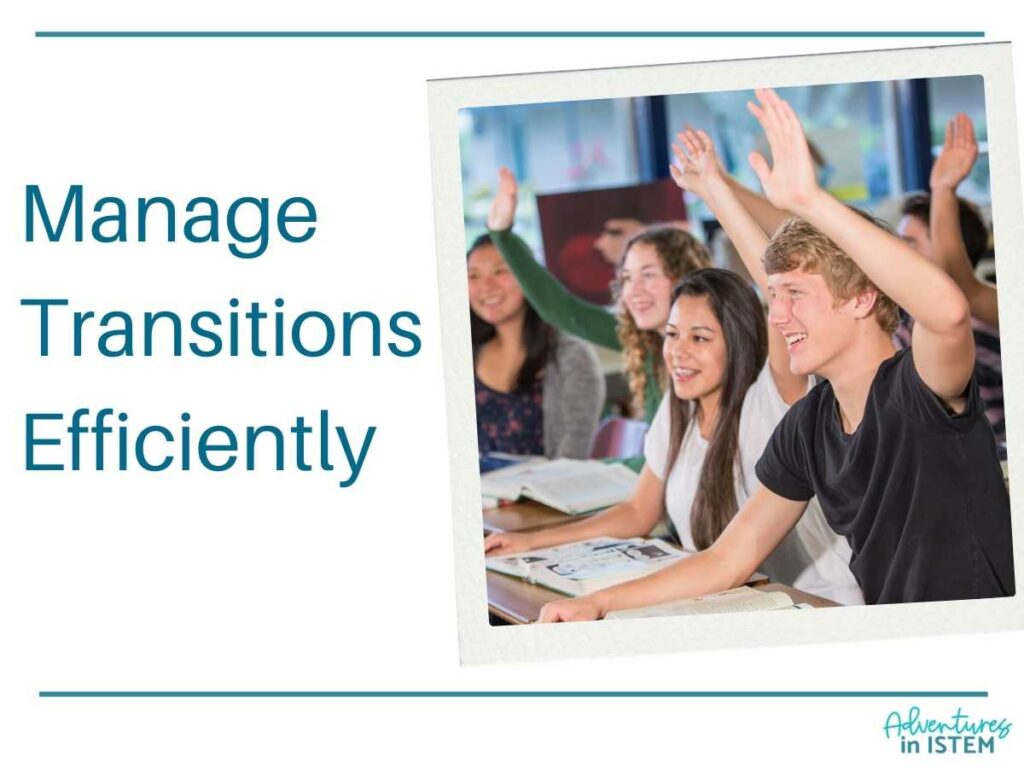An essential ingredient of having a great school year is having an effective classroom management strategy. Whether you are a new teacher just starting out or have been in the classroom for 30 years. Classroom management is something that should always be a work in progress.
Having an effective classroom management strategy is not just about keeping order; it’s about encouraging a positive classroom culture and ensuring that each student has the opportunity to thrive. Here are some practical, proven strategies I use in my classroom to help limit unwanted behaviors.
Classroom Management Strategy Example #1: Establish Daily Routines

Establishing clear, consistent routines is crucial for creating a structured learning environment. Routines help students understand what is expected of them and reduce anxiety by eliminating uncertainty. Routines streamline classroom operations, making it easier for students to transition between tasks and focus on learning.

I like to begin the day with a structured entry routine where students are immediately engaged with the class agenda displayed on the board. I have them write the daily agenda and homework in their class planner, take out what they need for the day’s lesson, and place their backpack against the wall. I find that they are more focused when they don’t have their backpacks with them, and it allows me to move around the classroom more easily without worrying about tripping on a backpack.
Next, I have them start working on a short warm-up activity. This activity might vary, but it might include something designed to get them thinking about today’s activity, reviewing a previous day’s lesson, having an SEL check it to see how they are doing, or practicing a skill like interpreting graphs.
At the end of the day, I like to wrap up the lesson with a quick check for understanding and sometimes a reflection on what they learned that day. I also provide time for them to return their materials and clean up for the day.
I also have a routine for daily tasks. It is so much easier when there is a system for distributing and collecting materials. Plus, it helps minimize chaos and maximize instructional time. I have folders for each group. When I need to collect papers, the students place their papers in the group folder, and I have a student collect the folders. Once things are graded, I have a student pass the folders back out, and the students remove their papers from the folders.
I also have supply boxes for each group. These boxes contain markers, crayons, rulers, glue, pens, pencils, post-it notes, whiteboard markers, and calculators. I have a student grab the box for the group. First, they check that all of the supplies are still there. At the end of class, another student returns the box.
To reinforce these routines and help the students learn them, I have a checklist they keep in their notebooks and post the directions on the board. For the first month, I verbally gave them directions with visuals of them on the board to help them learn. I still find that some students forget the routines even when we do them every day, and it is now April, but I smile and kindly remind them. Yelling or getting upset does no good, and a simple smile and reminder quickly modifies the behavior.
Such routines reduce classroom chaos and ensure that no instructional time is lost. The students leave the classroom organized and ready for the next day or class.
Classroom Management Strategy Example #2: Create a Positive Classroom Environment
Students who feel welcomed and cared for are less likely to cause problems and more likely to get their work done. This is why creating a positive classroom environment is one of the key ingredients for having excellent classroom management.

Student-Driven Expectations: I like to involve students in setting their own student expectations for the classroom. This method empowers them, giving them a sense of ownership and responsibility. Have students brainstorm what a positive learning environment looks like and collectively decide on the most essential rules. They then work as a group to narrow it down to the top 5. Finally, we have a class vote on the top 5-10 student expectations. I turn it into a poster that we all sign.
Daily Welcoming Rituals: Having some way to welcome the students into your class helps set the day’s tone. These small gestures significantly impact a student’s mood and feeling of being seen. I like to start by playing music for them to enjoy as they enter my classroom. I also greet them by their name and include a handshake or fist pump and a smile. Sometimes, I also use this time for a quick check-in to see how they are doing.
Life Skills Integration: I regularly integrate social-emotional learning lessons, such as mindfulness or habits of success activities. I like to take one day a week to focus on this, but it can be done with just a quick 5-minute lesson.
I created lessons that help students understand how mindfulness can affect their brain, help them become less anxious, and help them with their self-regulation. I also created lessons that help students learn the habits of successful people, like taking responsibility, goal setting, embracing feedback, and practicing persistence. These lessons show students that you care about their well-being beyond academic achievements.
I like to personalize interactions by using the information gathered from the initial ‘get to know you’ activities I do at the beginning of the school year. For example, if a student is interested in sports or a specific team, I might briefly discuss how the team performed in a current game. I might also use that sport to teach a science concept. If students love drawing or music, I might have them demonstrate their knowledge through a song or illustration.
You will want to start by involving students in creating classroom norms and expectations right from the beginning of the school year. Use surveys or “get to know you” activities to gather their input on what makes a supportive learning environment. For welcoming rituals, set a few minutes each morning to engage in these activities, creating a routine that students look forward to. Incorporate life skills lessons into your weekly schedule, ensuring these are consistent and adapted to the needs of your students.
Together, these strategies create a classroom environment where students feel respected, involved, and cared for, significantly enhancing their engagement and participation.
Classroom management Strategy example #3: Manage Transitions Efficiently
Nothing wastes time more than moving from one task to another. I have found that if I don’t have a straightforward routine, students will spend their sweet time going from one activity to the next. This is why it is important to have a smooth transition to keep students focused and minimize downtime, which can lead to unwanted behaviors.

A visual timer can indicate the remaining time for an activity, preparing students for upcoming transitions. Also, having a clear signal for transitions, such as a bell, phrase, or specific music, can effectively indicate when it’s time to change tasks. Structured routines for moving between activities also help students know exactly what to do next.
I have tried lots of different attention-getters in the past. The three I use the most are a large-sounding bell courtesy of my grandma. I use this one when the students are in group activities that require high energy. Another one I like is the 5-second countdown. I raise my hand and count down to 5. Then, when I don’t want to add to the sound volume, I raise my hand, put my finger over my lips, and make eye contact with students, who do the same until everyone has their hand up and finger over their mouth.
Planning the day in short, manageable segments with specific cues for transitions can help keep students organized and attentive. Practicing these transitions during the first weeks of school establishes a smooth routine. Plus, breaking your lesson up into small chunks helps the students process the information and retain it better.
Well-managed transitions enhance focus and provide timely feedback on student progress. They reduce wasted time and help maintain a calm, orderly classroom environment.
Classroom Management Strategy Example #4: Build Meaningful Relationships with Students
It is so important to build strong, respectful relationships with students. This is another key foundation for effective classroom management. These relationships influence classroom dynamics and significantly impact student behavior and engagement. I have found that many times, students who act out in other teachers’ classes don’t in mine simply because of the relationship I have built with them.

Personalized Check-Ins: I like to regularly check in with students individually, asking about their interests, challenges, or any assistance they might need. It doesn’t take a lot of time and can be done during quiet work times or when students enter or leave the class. These seemingly quick, simple checks can make a huge impact.
Shared Experiences: Create opportunities for shared experiences, such as class projects or group outings related to the curriculum. These activities allow for informal interactions and shared memories, which can strengthen bonds between you and your students. I like to start the first day of school with a team building challenge to help them get to know their group members.
Open Door Policy: Implement an ‘open door’ policy where students feel comfortable approaching you with their concerns or achievements. This could be literal—keeping your classroom door open at certain times—or figurative, reassuring students that they can come to you anytime. I have a Google form that my students can fill out to let me know if they are having a bad day that I can quickly check while they are doing their warm-up. They can let me know if they need to talk to someone about it or a break that day.
Interest-Based Clubs or Activities: Start a club or weekly activity session that aligns with your students’ interests, whether it’s a book club, science club, or art workshop. Participating alongside your students can break down formal barriers and foster a sense of camaraderie. At my school I am the advisor of our broadcasting club which helps to put out our schools newscast and our schools GSA club.
Responsive Communication: Always listen actively when students speak to you, showing that you value their thoughts and opinions. Responsive communication involves hearing them out and providing thoughtful feedback or follow-up questions, showing engagement in the conversation. Sometimes, they don’t need you to solve the problem; they need to know that someone knows what they are going through.
Begin by setting aside a few minutes each day or week specifically for these relationship-building activities. For personalized check-ins, keep a log to ensure you connect with each student regularly. Organize and participate in class projects or field trips that allow for relaxed and enjoyable interaction. Make it clear to students that your door is always open for them to share their thoughts or concerns and actively participate in clubs or activities based on their interests.
When students know their teacher is genuinely interested in their well-being and success, they are more likely to engage in learning and exhibit positive behaviors. Strong relationships not only improve classroom management but also enhance the overall learning experience for students, contributing to their personal and academic growth.
Effective classroom management is a skill that evolves with your teaching experience. I am constantly improving and modifying my classroom management techniques to suite the students I have today.
By implementing these strategies, you can create a structured and supportive environment where effective teaching and enriched learning experiences occur. Experiment with these techniques to discover what best suits your teaching style and classroom dynamics, and watch as your classroom transforms into a vibrant learning community.
For more resources on how to set a positive learning environment check out my blog post on How to Build Positive Relationships with your students.





